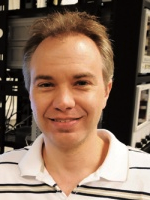Go to
Ken Shepard
From Single-Molecule Biophysics to Neural Interfaces -- The Case for CMOS Bioelectronics
From the imaging of multicellular organisms to the study of individual molecules, the most popular experimental techniques are based on light microscopy. Light imaging can be advantageous because it is orthogonal to most biophysical processes, allowing non-invasive interrogation. By the same measure, photons do not naturally interface with most biological functions. With notable exceptions, living systems instead rely on chemical, mechanical, and electrical interactions rather than optical phenomena, although living systems can be genetically engineered to respond to light. Despite this, non-optical pathways offer considerable advantages in interfacing directly to biological and biomolecular systems without the need for labeling or genetic engineering. Detection based on ionic or electronic transport can yield much larger signals than those produced from typical fluorophores, allowing high levels of sensitivity to be achieved at high measurement bandwidths. Integrating sensor transduction onto CMOS chips provides further advantages by enabling reduction of parasitics and improved sensor density. We present details on several integrated-circuit-based bioelectronic sensing platforms that demonstrate the range of capabilities of CMOS-based bioelectronics, including high-bandwidth single-molecule measurements, electrochemical imaging of signaling molecules in multicellular communities, and neural interfaces.
About the speaker:
Kenneth L. Shepard received the B.S.E. degree from Princeton University, Princeton, NJ, in 1987 and the M.S. and Ph.D. degrees in electrical engineering from Stanford University, Stanford, CA, in 1988 and 1992, respectively. From 1992 to 1997, he was a Research Staff Member and Manager with the VLSI Design Department, IBM T. J. Watson Research Center, Yorktown Heights, NY, where he was responsible for the design methodology for IBM’s G4 S/390 microprocessors. Since 1997, he has been with Columbia University, New York, where he is now Professor of Electrical Engineering and Biomedical Engineering. He also was Chief Technology Officer of CadMOS Design Technology, San Jose, CA, until its acquisition by Cadence Design Systems in 2001. His current research interests include power electronics, carbon-based devices and circuits, and CMOS bioelectronics.
Secondary navigation
- EPFL Workshop on Logic Synthesis and Emerging Technologies
- Luca Amaru
- Luca Benini
- Giovanni De Micheli
- Srini Devadas
- Antun Domic
- Rolf Drechsler
- Pierre-Emmanuel Gaillardon
- Jie-Hong Roland Jiang
- Akash Kumar
- Shahar Kvatinsky
- Yusuf Leblebici
- Shin-ichi Minato
- Alan Mishchenko
- Vijaykrishnan Narayanan
- Ian O'Connor
- Andre Inacio Reis
- Martin Roetteler
- Julien Ryckaert
- Mathias Soeken
- Christof Teuscher
- Zhiru Zhang
- Symposium on Emerging Trends in Computing
- Layout synthesis: A golden DA topic
- EPFL Workshop on Logic Synthesis & Verification
- Luca Amaru
- Luca Benini
- Robert Brayton
- Maciej Ciesielski
- Valentina Ciriani
- Jovanka Ciric-Vujkovic
- Jason Cong
- Jordi Cortadella
- Giovanni De Micheli
- Antun Domic
- Rolf Drechsler
- Henri Fraisse
- Paolo Ienne
- Viktor Kuncak
- Enrico Macii
- Igor Markov
- Steven M. Nowick
- Tsutomu Sasao
- Alena Simalatsar
- Leon Stok
- Dirk Stroobandt
- Tiziano Villa
- Symposium on Emerging Trends in Electronics
- Raul Camposano
- Anantha Chandrakasan
- Jo De Boeck
- Gerhard Fettweis
- Steve Furber
- Philippe Magarshack
- Takayasu Sakurai
- Alberto Sangiovanni-Vincentelli
- Ken Shepard
- VENUE
- Panel on Circuits in Emerging Nanotechnologies
- Panel on Emerging Methods of Computing
- Panel on The Role of Universities in the Emerging ICT World
- Panel on Design Challenges Ahead
- Panel on Alternative Use of Silicon
- Nano-Bio Technologies for Lab-on-Chip
- Functionality-Enhanced Devices Workshop
- More Moore: Designing Ultra-Complex System-on-Chips
- Design Technologies for a New Era
- Nanotechnology for Health
- Secure Systems Design
- Surface Treatments and Biochip Sensors
- Security/Privacy of IMDs
- Nanosystem Design and Variability
- Past Events Archive

